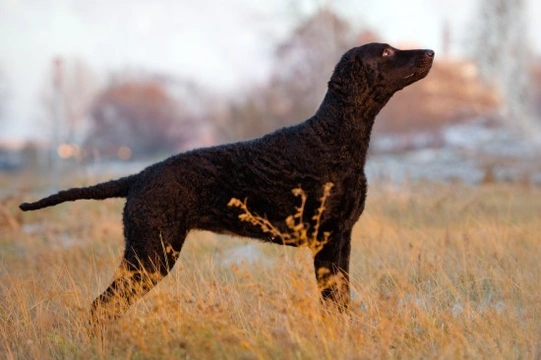
Is a curly coated retriever the right choice of dog for you?
The curly coated retriever is the tallest of all of the retriever dog breeds, and along with the flat-coated retriever, one of the oldest recognised retriever breeds too, which was originally bred to hunt waterfowl and upland birds.
Their build and conformation is rather different to that of most of the other retriever breeds, being tall and leggy, and just a touch longer than they are tall. They stand up to 27” tall at the withers, but the size range for the breed can be quite variable, with field dogs often being significantly smaller.
The coat of the curly coated retriever is one of its most defining features, having very tightly curled fur that is very good at shrugging off water and thorns. Their faces are generally smooth, making quite the contrast with their curly bodies! The breed can be seen in either black or liver colouration, with no patches or other markings; even the dog’s nose should be the same colour as the coat!
If you love dogs from the retriever grouping and are looking for something a little different in your potential future dog, the curly coated retriever is definitely worthy of consideration. In this article, we will cover the temperament and some of the core traits of the breed in more detail. Read on to learn more.
What is their temperament like?
The curly coated retriever’s working history is as a gun dog, and they are soft mouthed, gentle and kind. Like most retriever breeds, they have made the transition to modern domestic life relatively easily, and assuming that their needs are met and they get enough exercise, they make for great family pets.
They are lively and active when outside but calm and laid back within the home, and are very affectionate, forming strong bonds with their families. They are kind and gentle with children and like to be involved in family life, but they can be a little shy with strangers.
Do they need a lot of exercise?
As a breed with a long working history that is used to being outside for large parts of the day and exhibits plenty of endurance, the curly coated retriever has a medium to high exercise requirement. They need to be permitted to play outside with supervision and go on several walks per day, and like lots of variety, games such as catch, and to be able to run and explore off the lead.
They are also generally good swimmers, and actively enjoy playing in and around water, and their tightly curled coats are designed to shrug off rain and wet weather with ease. They like to spend plenty of time outside with someone to play with, and are not afraid of going out even when the weather is very wet or cold!
Are they easy to train?
The curly coated retriever is ranked around the middle of the pack in terms of canine intelligence, making them reasonably fast learners that need an alert, switched on trainer that can keep things interesting. Their training sessions should be short, varied and interspersed with periods of play, and can be begun from an early age and continued throughout the dog’s life.
They benefit from consistent positive reinforcement training with lots of praise, and they work hard to learn new skills and try to please and impress their handlers. They are well suited to canine sports due to both their intelligence and build, and generally take well to activities including canine agility, flyball and obedience.
Do they get on well with other animals?
The curly coated retriever, like all dogs, needs to begin the process of socialisation and learning how to behave with other dogs from an early age. Assuming that this is achieved, they are generally very personable with other dogs, and very much enjoy playing and running around with both familiar dogs and strangers. They generally get on well having another canine companion within their home, and another dog that is lively and active is a good match for them, with the two dogs going some distance to keeping each other happy and entertained.
Providing that they are introduced properly, the curly coated retriever can also generally live side by side with a cat without a problem.
What sort of homes do they need?
The curly coated retriever needs to live with an active, outdoors-y family that has plenty of time to devote to spending with their dog, and that likes to play and involve the dog in every aspect of family life. The breed gets on well with children, and enjoys playing with them, and is normally calm and kind with kids of all ages.
The dog will soon become bored and unhappy if they are insufficiently exercised or do not have enough to do, but within the right type of living environment, they are good natured, happy and very personable pets to own.



